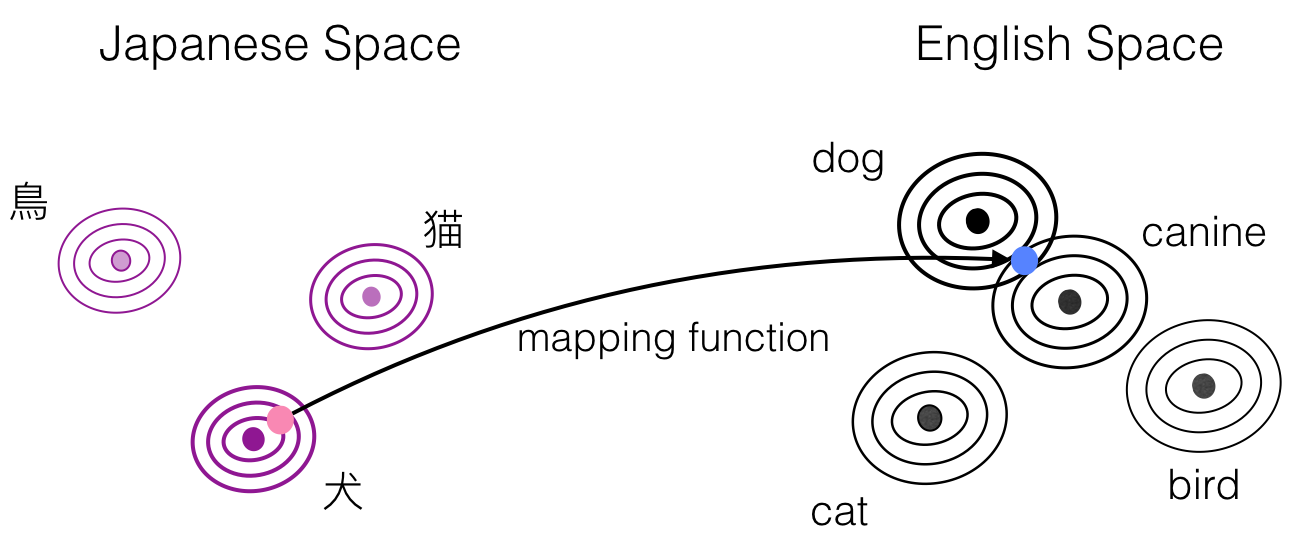This is the PyTorch implementation for Density Matching for Bilingual Word Embedding, accepted by NAACL 2019.
DEMA-BWE expresses the two monolingual embedding spaces as probability densities defined by a Gaussian mixture model, and matches the two densities using normalizing flow. The method requires no explicit supervision, and can be learned with only a seed dictionary of words that have identical strings. This formulation has several intuitively attractive properties, particularly with the respect to improving robustness and generalization to mappings between difficult language pairs or word pairs. We achieved strong results on the bilingual lexicon induction and cross-lingual word similarity.
- Python 3.6
- PyTorch 0.4
-
Create a conda environment with Python 3.6 .
conda create -n dema python=3.6
-
Activate the conda environment.
source activate dema -
Install the requirements
pip install -r requirements.txt
-
Install fastText from here.
-
Install PyTorch=0.4.1
pip install https://download.pytorch.org/whl/cu80/torch-0.4.1-cp36-cp36m-linux_x86_64.whl
-
Install the GPU version Faiss from here.
We use embeddings trained with FastText in the binary format and the bilingual dictionaries from MUSE.
- You can get evaluation datasets from here.
- You can get monolingual FastText binary vectors from here or train your own monolingual embeddings with FastText.
First, cd scripts, sample scripts are included under the directory of scripts/.
train*.sh are scripts to learn bilingual mappings for a pair of languages,
train.sh can be used to reproduce results in the paper except for ja and zh.
train_zh.sh and train_ja.sh can be used to learn mappings between en and zh, en and ja, respectively.
Just simply run:
bash train*.shTo learn the bilingual word mappings between a pair of languages,
first prepare the pretrained word vectors and evaluation data set,
then set data_path accordingly in the script.
Also set src_lang and tgt_lang respectively, note that the model learns the bidirectional mappings simultaneouly.
You might need to tune the hyperparameters of
--s_var (variance of source language from source to target),
--s2t_t_var (variance of target language from source to target),
--t_var (variance of target langauge from target to source) and
--t2s_s_var (variance of source langauge from source to target)
for better performance.
You can evaluate learned bilingual mappings on the bilingual lexicon induction (BLI) task
or perform Procrustes refinement
using the run_eval.sh script under scripts/.
Set the data_path and load_path correspondingly in the script, where data_path
is the path to FastText binary word embeddings and evaluation datasets from MUSE.
load_path is the path to the stored bilingual mapping matrices.
--n_refinement: if set to be an integer > 0, Procrustes refinement will be performed for this number of times (usually set to be 5).
--export_emb: if set to be 1, mapped embeddings will be stored under ./eval, e.g de.vec and en2de.vec are both in the German space.
Note that the bilingual embedding mappings are learned on top of the normalized embeddings described in the paper,
we also provide script export.sh to export embeddings in the shared space.
Simply set the data_path and load_path as in the Evaluation section.
--vocab_size can be used to specify the number of most frequent words in the monolingual embeddings to be mapped to the other language.
The bilingual word embeddings will be saved under ./eval similarly as above, which can be directly used as cross-lingual embeddings for cross-lingual transfer.
We provide pretrained bilingual embedding mappings reported in the paper here.
@inproceedings{zhou19naacl,
title = {Density Matching for Bilingual Word Embedding},
author = {Chunting Zhou and Xuezhe Ma and Di Wang and Graham Neubig},
booktitle = {Meeting of the North American Chapter of the Association for Computational Linguistics (NAACL)},
address = {Minneapolis, USA},
month = {June},
url = {https://arxiv.org/abs/1904.02343},
year = {2019}
}

